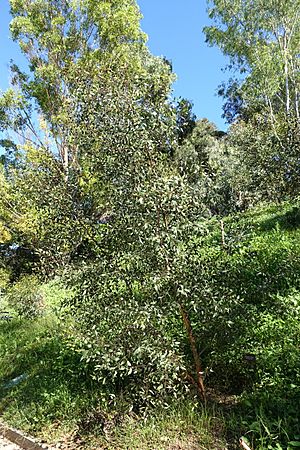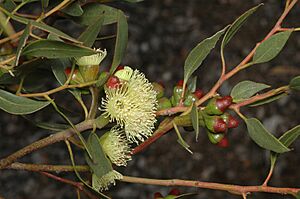Red-flowered moort facts for kids
Quick facts for kids Red-flowered moort |
|
|---|---|
 |
|
| Eucalyptus nutans habit (cultivated specimen) | |
| Conservation status | |
| Scientific classification | |
| Genus: |
Eucalyptus
|
| Species: |
nutans
|
The Red-flowered Moort, officially known as Eucalyptus nutans, is a special kind of eucalyptus tree. It only grows in a small part of Western Australia, near the southern coast. This tree has smooth bark and leaves that are shaped like ovals or circles. Its flowers are usually red or pink, and they grow in groups of seven. After flowering, it produces fruit that looks like a cup or cone.
Contents
What the Red-flowered Moort Looks Like
The Red-flowered Moort is a small tree with a single main stem. It usually grows to be about 4 to 10 metres (13 to 33 feet) tall. This tree has smooth bark that can be light brown or grey. Unlike some other eucalyptus trees, it does not have a lignotuber, which is a woody lump at the base that helps the plant regrow after a fire.
Its adult leaves are shiny green on both sides. They are shaped like an ellipse, an oblong, or almost a circle. These leaves are about 52 to 73 millimetres (2 to 3 inches) long and 33 to 50 millimetres (1 to 2 inches) wide. Each leaf has a small stalk called a petiole, which is about 7 to 15 millimetres (0.3 to 0.6 inches) long.
Flowers and Fruit
The flower buds of the Red-flowered Moort grow in groups of seven. They are found in the axils of the leaves, which is where the leaf joins the stem. These buds grow on a flat, wide stalk called a peduncle, which can be about 55 millimetres (2.2 inches) long. The individual buds either sit directly on the stalk (called sessile) or have very short stalks (called pedicels) up to 2 millimetres (0.08 inches) long.
Mature buds are shaped like a cone and are slightly bumpy. They are about 8 to 11 millimetres (0.3 to 0.4 inches) long. Each bud has a cap called an operculum that is also cone-shaped. The flowers bloom between November and April. Their stamens (the parts that produce pollen) are usually red, but sometimes they can be cream-coloured.
After the flowers, the tree produces woody fruit. This fruit is shaped like a cup or a cone and is about 22 millimetres (0.9 inches) long. It has four small wings along its edge and five parts that open up to release seeds. The seeds themselves are black and oval-shaped.
How it Got its Name
The Eucalyptus nutans was first officially described in 1863 by a scientist named Ferdinand von Mueller. He found specimens (samples) of the tree collected by George Maxwell near Bremer Bay. Mueller wrote about it in his book, Fragmenta phytographiae Australiae.
The name nutans comes from a Latin word that means "nodding." This refers to how the flowers of this tree tend to hang downwards, as if they are nodding.
Where the Red-flowered Moort Grows
This special mallet tree is only found in one place near Bremer Bay. It grows in a group of its own kind, mixed with other plants. Some of the other plants found there include Acacia glaucoptera, A. cyclops, Hakea laurina, Eucalyptus phenax, E. occidentalis, Rhadinothamnus rudis, and different types of Lepidosperma and Astroloma.
Protecting the Red-flowered Moort
The Red-flowered Moort is considered a "Threatened Flora" by the Department of Environment and Conservation (Western Australia). This means it is a rare plant that needs protection. It is only known to grow in one small area, covering just a few hectares, where there are several thousand plants.
Sadly, many of these trees were destroyed in a large fire in 1995. Even though it's rare in nature, some Red-flowered Moort trees are grown in other places, like in gravel pits near Albany and at Kings Park Botanic Garden. These cultivated trees grew from seeds collected between 1968 and 1989.




